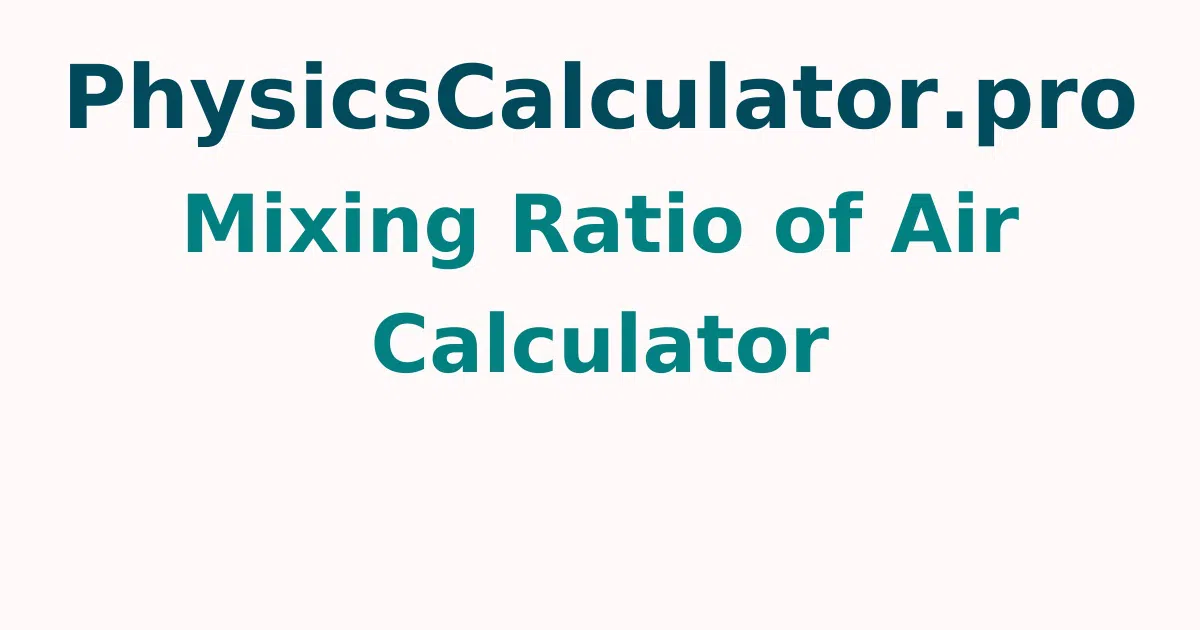Mixing Ratio of Air Calculator
Our mixing ratio of air calculators will help if you've ever been puzzled about how weather reports can measure humidity so precisely. Continue reading to learn how these two variables are related, how increasing the vapour pressure affects them, and how to measure water vapour in the air! Of course, we'll show you how to calculate the real mixing ratio!. Keep in mind that the mixing ratio is calculated in a physical (or meteorological) since using this tool. If you're more interested in chemistry, take a look at our other mixing ratio calculator.
What are the mixing ratios in actual and saturation?
The mass of water vapour to dry air is the actual mixing ratio. Although this quantity is connected to total dry air plus aqueous vapour, it is similar to the specific humidity. For example, Science is not often employed in everyday life. The findings of the air calculator's mixing ratio can be utilized in the following ways:
Meteorology, in order to calculate relative humidity and track the attributes of air masses. Further, this can be used in weather forecasting and can help you sleep better by assuring that your well-deserved vacation will not be disrupted by poor weather conditions.
Engineering, for example, in air conditioning and water vapour transport calculations to control room humidity. You could appreciate it, especially during the winter when heaters dry out the air and make it uncomfortable to breathe.
Microclimate studies are being conducted to explore the effects of infiltration, which occurs when the outside air is mistakenly brought into a structure. The actual mixing ratio, rather than relative humidity, is a more sensitive technique for distinguishing different air streams. A hot kitchen and a frigid Alaskan street may have equal humidity levels but different mixing ratios.
The atmospheric thermodynamics value of the virtual temperature of a parcel of air is determined using atmospheric thermodynamics. This is the temperature of dry air at the same pressure and density as a sample of moist air.
So, what exactly is a saturation mixing ratio? At a given temperature and pressure, this is the maximum amount of water vapor that the air can store without condensation. Understanding that air is saturated when it can no longer hold any more H2O in the gaseous state may aid comprehension.
How do you determine the amount of water vapor in the air?
Cloud formation, precipitation, and heat index are all affected by H2O in its gaseous state. As a result, it's only reasonable that we'll all want to calculate its value in order to forecast the weather. You can do this with a particular device, such as a hygrometer, or with calculations, such as utilizing our air mixing ratio calculator.
Although the mixing ratio and absolute humidity both contain information on the amount of water vapor in the air, they are rarely employed in everyday life. Instead, weather reports prefer to focus on relative humidity, which is represented as a percentage and evaluates how near the air is to being saturated.
Become familiar with plenty of similar concepts of physics along with well designed calculator tools complementing the concept on Physicscalculatorpro.com a trusted reliable portal for all your needs.
FAQs on Mixing Ratio of Air Calculator
1. What's the difference between humidity and dew point?
The relative humidity is the percentage of saturation at a given temperature, whereas the dew point is the temperature at which water vapour is saturated in the air. The dew point is proportional to the amount of moisture in the air and indicates the temperature at which the relative humidity is 100%.
2. What is the effect of increasing the vapour pressure on the mixing ratio?
Making one quantity greater will result in an increase in another since the mixing ratio is proportional to the actual vapour pressure. As a result, as the dew point rises, the vapour pressure and mixing ratio rise as well.
3. In a humidified environment, what is the mixing ratio?
The mixing ratio (also known as specific humidity) is a term that comes closest to our intuitive concept of concentration, which is the amount of one component in a combination. The weight of water vapour blended into a given weight of dry air is known as the water vapour mixing ratio. kg/kg is the unit of measurement.
